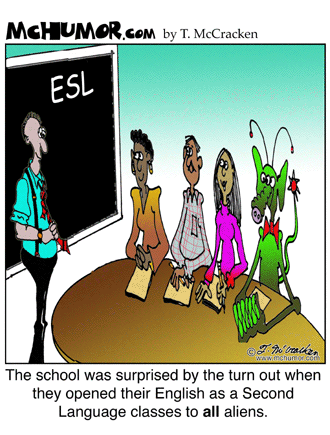
Do you understand what is funny in this cartoon?
If you understand the humor of any particular nation, that means you’ve achieved a very important milestone (point on your journey toward any goal). Humor is the essence of any particular nation’s collective experience. Just think about it: if millions of people find something amusing and funny, there is a deep meaning to that joke, cartoon, or story for so many people speaking your target language. If you don’t understand what’s funny, you’re not fluent…not yet. How do you learn the humor? What do you do to understand and appreciate the beauty and wit of a particular joke that most native speakers find funny? Good question. You just breathe it in, and wait till it resonates with your personal sense of humor.
One of my favorite American cartoonists (people who normally make you laugh by creating funny images with captions) is Garry Larson. He didn’t just draw funny pictures; he created a unique cartoon universe that could become an excellent guide to all of us, immigrants, toward understanding what Americans find funny, and why.
His sense of humor is not light and airy, but rather macabre (dark, sarcastic, sinister). At least it is macabre in American perception; I don’t see anything particularly dark or sarcastic, but then again, I’m Russian, and that means I have more tolerance to dark and sinister things. 
 Many jokes are based on ambiguity of some kind. Ambiguity is a situation when the same word or a combination of words could be understood in different ways. The ambiguities arise mostly in homophones (words that have the same pronunciation but different spellings and meanings) and homonyms (words that have the same pronunciation and spelling, but different meanings). A joke that exploits similar sounding words with different meanings is called a pun. Let’s take a look at one of them.
Many jokes are based on ambiguity of some kind. Ambiguity is a situation when the same word or a combination of words could be understood in different ways. The ambiguities arise mostly in homophones (words that have the same pronunciation but different spellings and meanings) and homonyms (words that have the same pronunciation and spelling, but different meanings). A joke that exploits similar sounding words with different meanings is called a pun. Let’s take a look at one of them.



Recent Comments